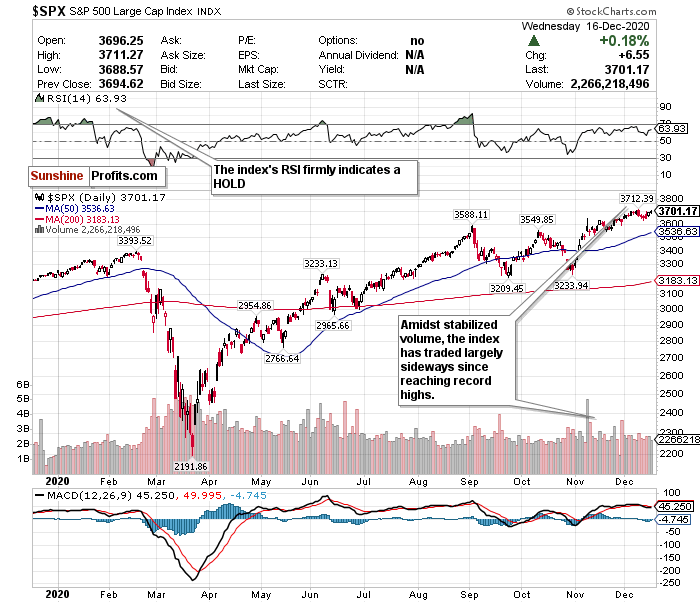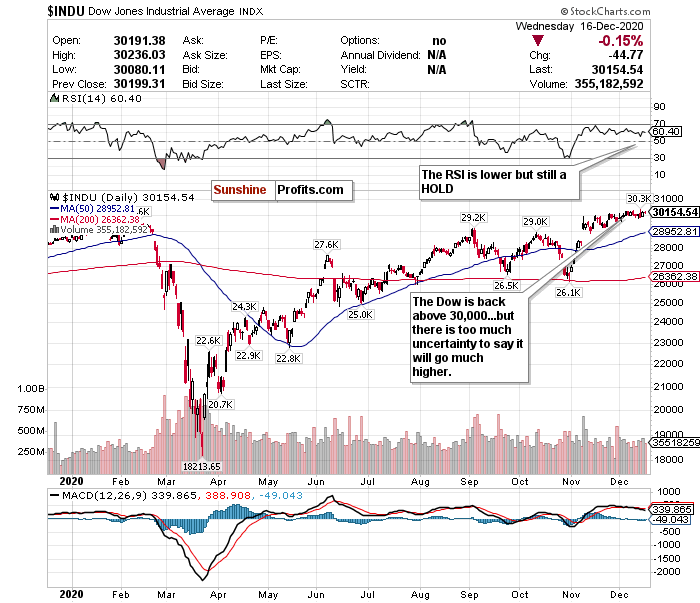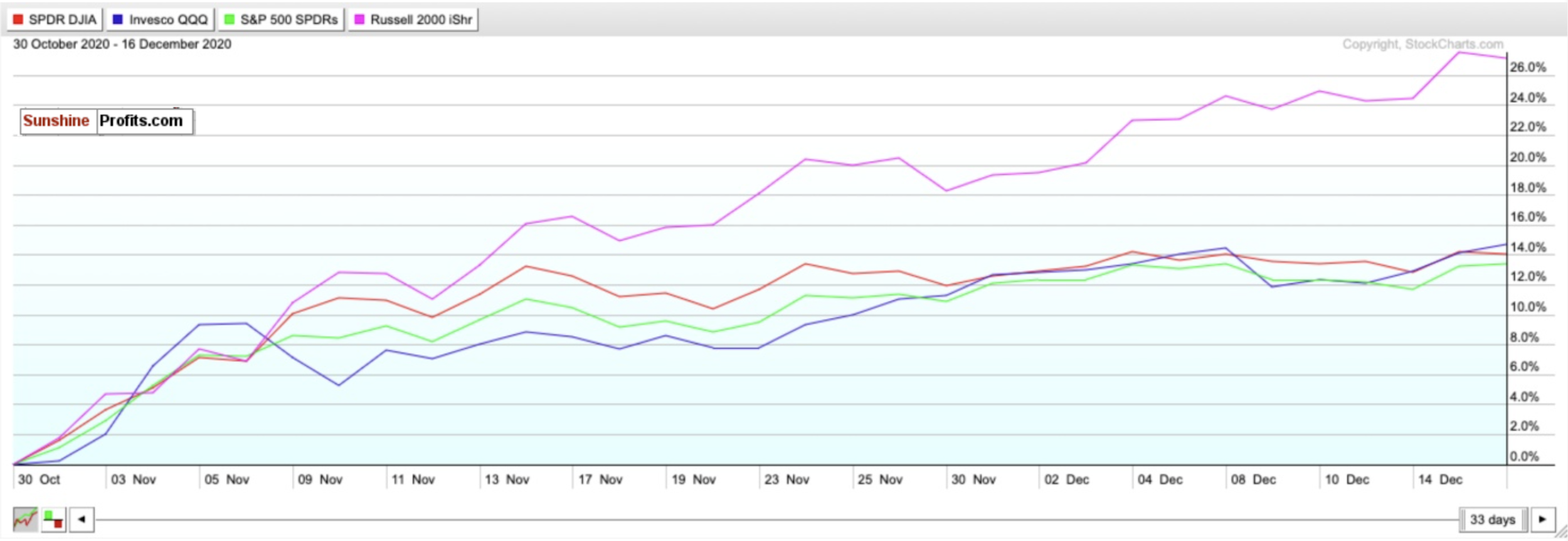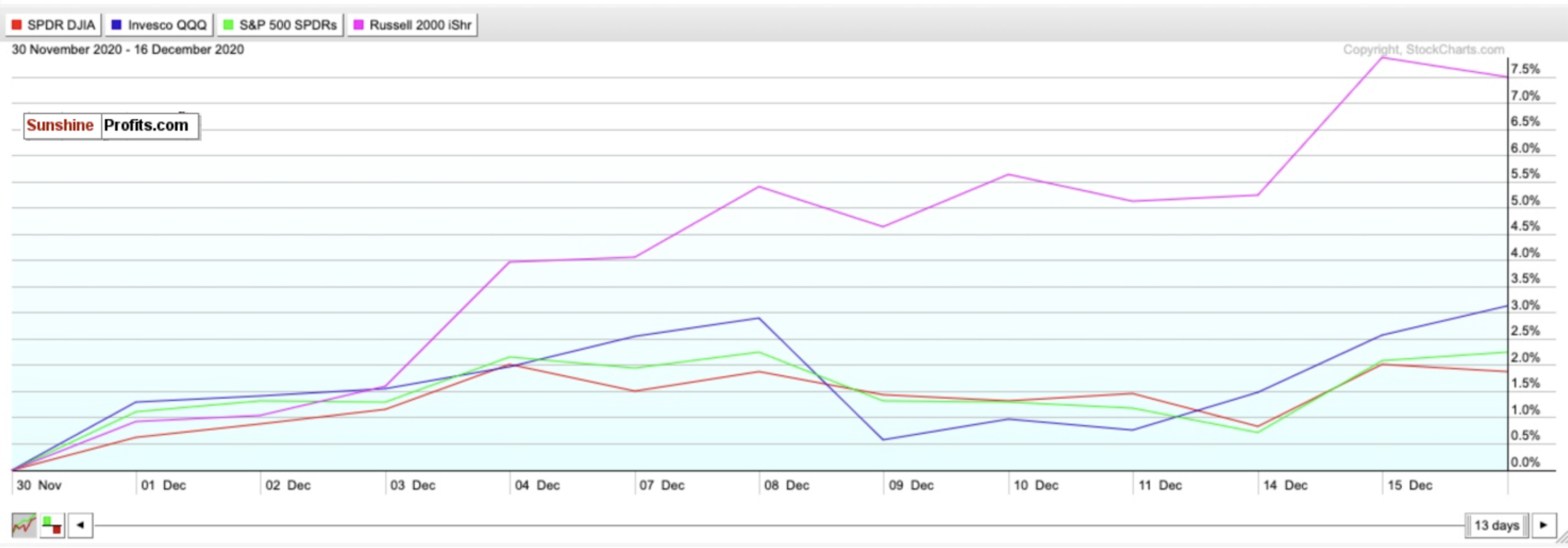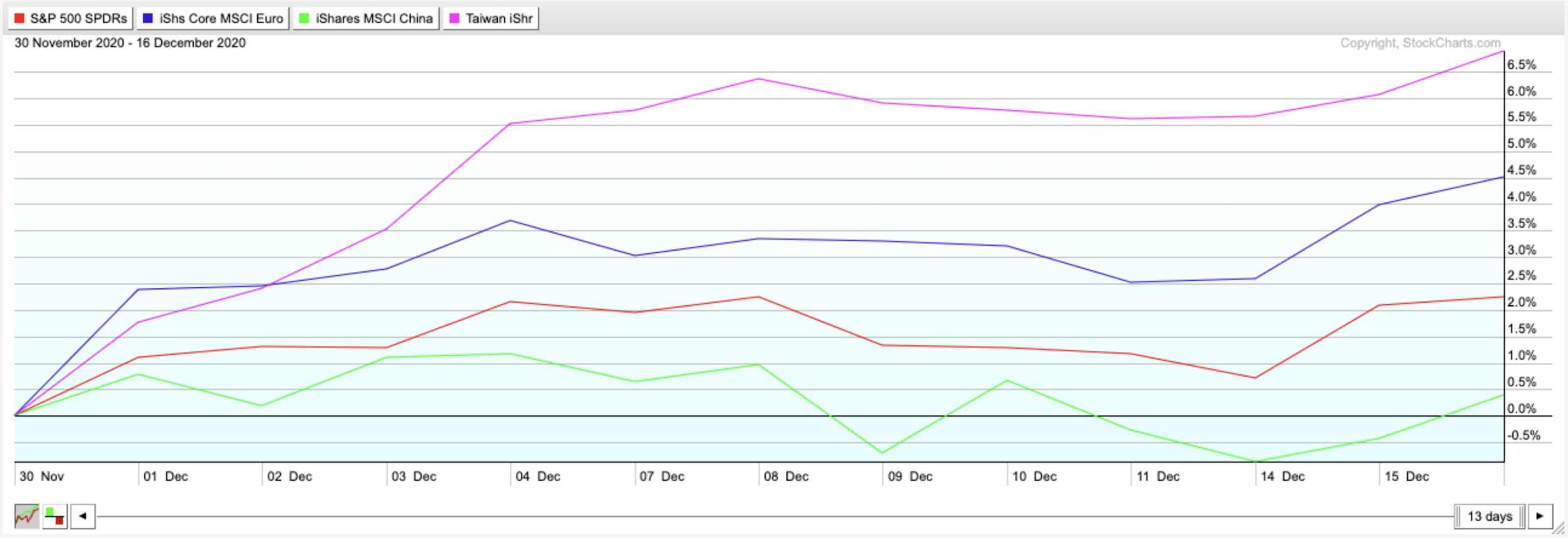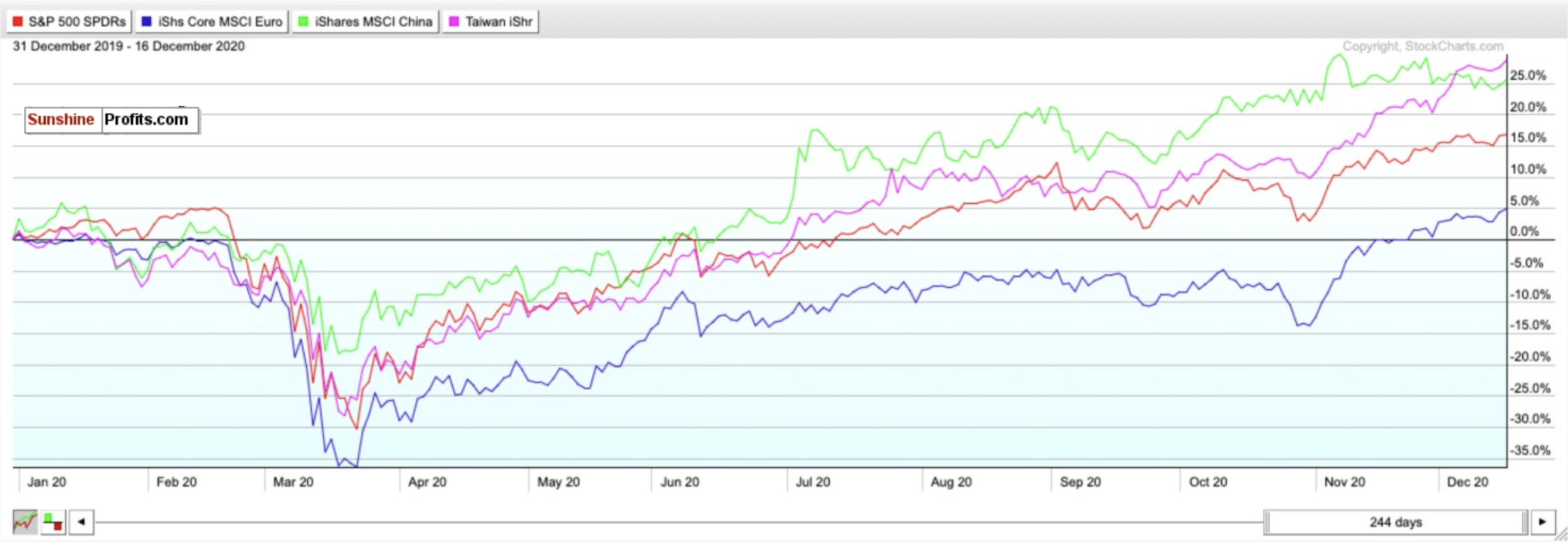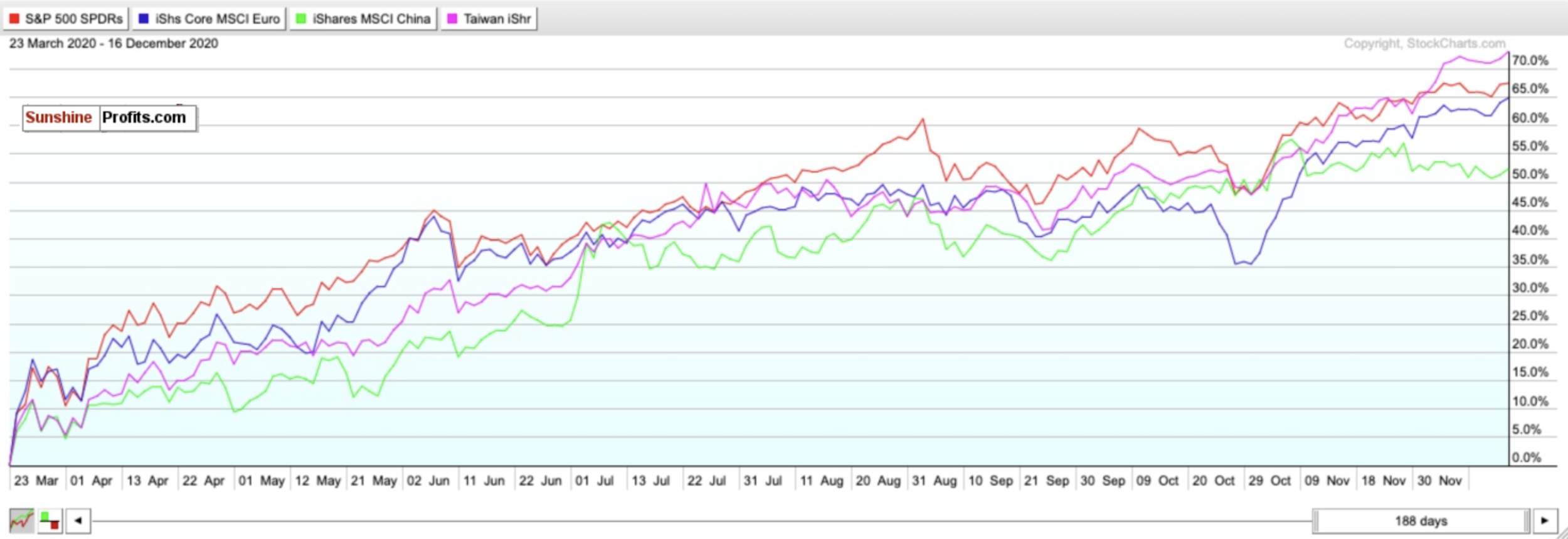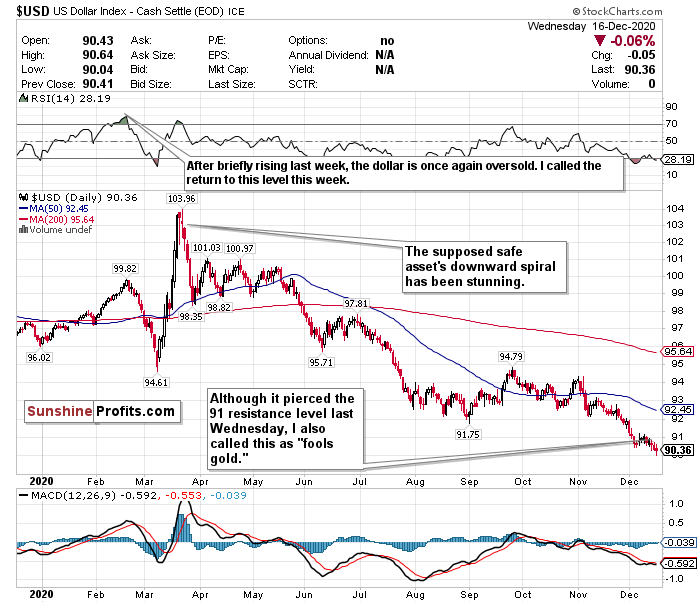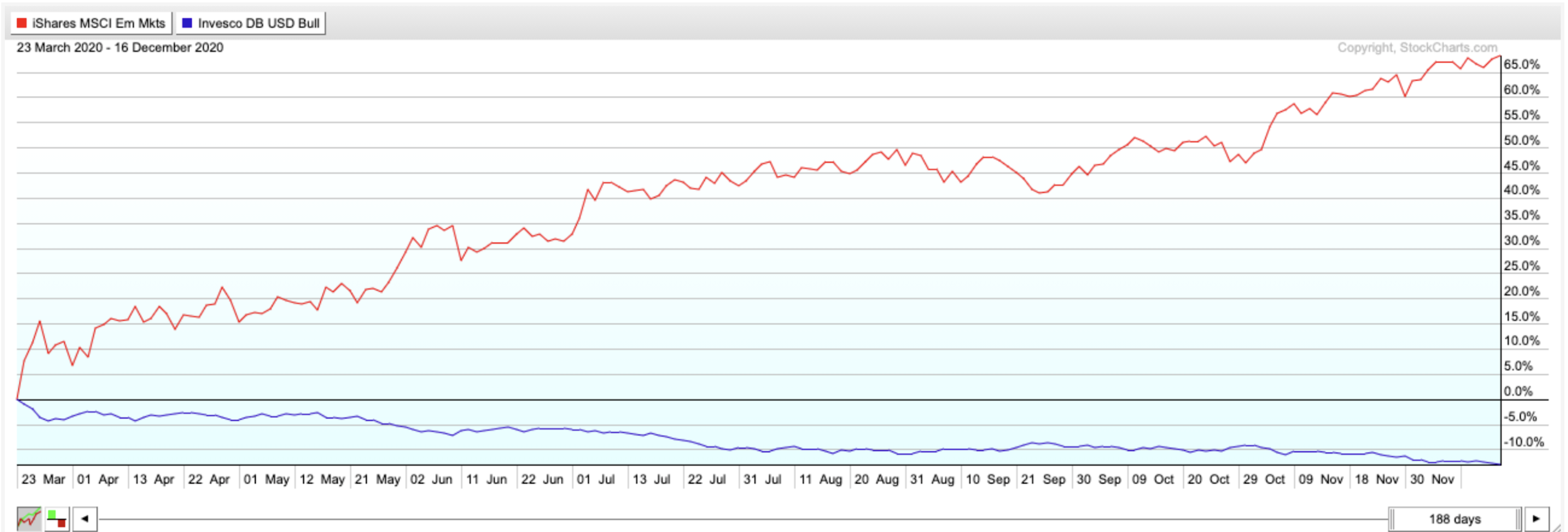The major indices closed mixed on Wednesday (Dec. 16), as the Nasdaq hit yet another record close amidst stimulus optimism and the Fed’s dovish tone.
News Recap
- Although the Dow Jones closed lower by 44.77 points, or 0.15%, the S&P 500 gained for the second day in a row and rose by 0.18%. The Nasdaq closed once again at a record high and gained 0.5%.
- Sentiment for the day started negatively after the Commerce Department reported a steeper-than-expected drop in U.S. retail sales. The department stated that retail sales fell by 1.1% in November compared to estimates of 0.3%.
- Cautious optimism that some sort of stimulus could be passed before the end of the year encouraged investors.
- According to Politico, Congress was on the brink of a $900 billion stimulus deal that would include a new round of direct payments to consumers. However, that package would exclude the more contentious areas of liability shields for businesses and state and local aid.
- We have reached the deadliest weeks of the COVID-19 pandemic. More than 300,000 total COVID-19 related deaths have now been confirmed in the U.S., with over 16 million confirmed cases. Additionally, US officials reported 3,400 new COVID-19 deaths - a daily record.
- After an FDA panel officially endorsed Moderna (MRNA) - following a review which confirmed safety and efficacy earlier in the week – the big day is finally here. On Thursday (Dec. 17), the FDA will officially vote on Moderna's vaccine. This will strongly complement the mass deployment of Pfizer (PFE) and BioNTech’s (BNTX) vaccine.
- The Federal Reserve’s announcement on monetary policy was largely as dovish as expected. The Fed vowed to continue its asset purchase program at the current rate, “until substantial further progress has been made toward the committee’s maximum employment and price stability goals.”
- Microsoft (MSFT) and Salesforce (CRM) led the Dow with gains of 2.4% and 1.6%, respectively, while Walgreens (WBA) was the laggard and declined 2.15%.
- Moderna (MRNA), despite its big week ahead, dropped 6.9%.
While there is some short-term uncertainty and mixed sentiment, there is some general consensus: While the short-term may see some pain and/or mixed sentiment, it may be worth it for the medium-term and long-term optimism.
The overwhelming majority of market strategists are bullish on equities for 2021- despite near-term risks. Outside of the pandemic raging to out of control levels, another near-term risk that has been largely overlooked is the Senate runoff election in Georgia. Investors have largely already priced in a divided government - however, if Republicans end up losing both seats in Georgia, this could potentially upend everything.
According to Jimmy Lee, CEO of the Wealth Consulting Group,
“I think that we can get a little bit of consolidation before year-end just due to normal selling at the year-end for rebalancing or tax loss harvesting. Also, depending on where the pulse is for the Senate race in Georgia, investors might want to get ahead of that if they think that capital gains taxes may go up in the future...So that could cause some additional selling before year-end and we could get a little bit of a pullback. But I am very bullish on equities at this point. And I do think we may get a little bit more of a rotation into the economy-opening sectors.”
Meanwhile, progress on the stimulus package appears to be more optimistic than many expected in the near-term.
“The odds of a fiscal deal before year’s end have been improving,” Goldman Sachs economists led by Jan Hatzius wrote in a note Tuesday (Dec. 15). “While we had expected a smaller package to pass now with a larger package waiting until early 2021, it appears increasingly likely that most of this could pass this week.”
While markets for the rest of 2020 (and perhaps early 2021), will wrestle with the negative reality on the ground and optimism for an economic rebound, the general consensus appears to be looking past the short-term painful realities, and focusing more on the longer-term - a world where COVID-19 is expected to be a thing of the past and we are back to normal.
In the short-term, there will be some optimistic and pessimistic days. On other days, such as Wednesday (Dec. 16) (and in my opinion this will be most trading days), markets will trade largely mixed, sideways, and reflect uncertainty. Therefore, it is truly hard to say with conviction what will happen with markets in the next 1-3 months. However, if a stimulus deal passes within the next week, it could mean very good things for short-term market gains.
In the mid-term and long-term, there is certainly a light at the end of the tunnel. Once this pandemic is finally brought under control and vaccines are mass deployed to the general public, volatility will stabilize, and optimism and relief will permeate the markets. Stocks especially dependent on a rapid recovery and reopening such as small-caps should thrive.
Due to this tug of war between sentiments, it is truly hard to say with any degree of certainty whether another crash or bear market will come.
Therefore, to sum it up:
While there is long-term optimism, there is short-term pessimism. A short-term correction is very possible. But it is hard to say with conviction that a big correction will happen.
The S&P Has Long-term Upside Mixed with Uncertainty
The S&P is back over that 3700 level. Amongst stabilized volume and an RSI in hold territory, I like where the index is. I just don’t like this level as a conviction buy. On the other hand, it is difficult to say with certainty that there will be a major downturn. While a stimulus appears imminent, I see simply too much near-term uncertainty.
However, many analysts and strategists believe this short-term uncertainty is worth it for long-term potential. I tend to agree with them, but I would prefer a sharper correction before making a conviction BUY call.
Some analysts believe the S&P could have up to a 20% upside in 2021, while others caution against an overheating index. According to another survey of market strategists conducted by CNBC, a narrow majority believe that U.S. stocks will continue to rally into 2021, with the S&P 500 rising between 8% and 22% next year from these current levels. This very well could be the case, but I personally believe most of this will happen in the next 6-12 months rather than 1-3 months.
Although the volume has largely stayed stable as of late, I would prefer a drop closer to below 3600 before feeling more confident in initiating a BUY call. For now, I keep the S&P 500 in a HOLD category.
For an ETF that attempts to directly correlate with the performance of the S&P, the SPDR S&P ETF (SPY) is a good option.
The Dow is Back Above 30,000...What Does it Mean?
The Dow Jones has now pierced that critical 30,000 level for the third time. However, it has largely lagged the other indices as of late.
I do like that it no longer appears to be overheating in the short-term. The Dow Jones has largely traded sideways and hovered slightly above and below the 30,000 level. Volume has been relatively stable too. I just have too many short-term questions as to whether or not the Dow can stay above 30,000 level for more than a week at a time - let alone exceed 30,250 and hit more all-time highs.
In my view, in the short-term, the Dow is just as likely to drop below 29,500 as it is to return to record highs.
Outside of the Russell 2000, the Dow may be the index most vulnerable to news and sentiment. On pessimistic “sell the news” kinds of days, the Dow may have more downside pressure than other indices, like Monday (Dec. 14). Many cyclical stocks that depend on a strong economic recovery trade on this index, and any change in sentiment can adversely affect their performances.
With so much uncertainty and the RSI still firmly in hold territory, the call on the Dow stays a HOLD.
This is a very challenging time to make predictions with conviction. But one thing I do believe is that IF there is a drop in the index, it will not be strong and sharp relative to the gains since March, let alone November. I believe that we could be in a sideways holding pattern as investors digest all the news being thrown at them on a daily basis. For an ETF that attempts to directly correlate with the performance of the Dow, the SPDR Dow Jones ETF (DIA) is a strong option.
Can Small-Caps Own December Too?
Although the Russell 2000 underperformed the major indices on Wednesday (Dec. 16) with a decline of over .50%, let’s be honest - it was bound to happen.
This is an index that, since November, has been on a run that could be described as nothing short of amazing. Since the start of November, the Russell 2000 has skyrocketed and considerably outperformed the other major indices. Just look how the iShares Russell 2000 ETF (IWM) compares to the ETFs tracking the Dow, S&P, and Nasdaq in that time frame. Since November, the IWM has risen over 26%. This is at least 12% higher than all of the other major indices.
The run has not stopped in December either. The IWM Russell ETF has surged by 7.5% since the start of the month. This is nearly between 4%-6% higher than the ETFs tracking the other major indices.
The Russell 2000 is an index especially dependent on news and sentiment and can experience greater volatility than larger-cap stock indices. Much of this can be attributed to the amount of cyclical stocks in the index that are dependent on the recovery of the broader economy.
If the last 9 months have shown us anything, it’s that Russell stocks will surge on optimistic days, and drop more on pessimistic days. However, recent trading days have bucked this trend. I do have some concerns of overheating - even more so than tech stocks. However, in the long-term, small-caps may be the best opportunity to bet on a 2021 economic recovery.
In the short-term, small-cap stocks may be the most volatile of all of them and may have overheated. However, my call is still HOLD.
If the index surges more, take short-term profits if you can - but do not fully exit positions.
On the other hand, if there is a pullback - consider initiating positions.
Mid-Term
Taiwan Continues To Outperform China and Other Markets
Although investors remain bullish on emerging markets in both the short-term and medium-term, it really depends on the region. While China, for example, gets most of the attention and is by far the largest presence in emerging market indices, Taiwan continues to quietly distance itself the top performing emerging market of 2020- and by a lot.
As seen in the chart above, since the start of December, the MSCI China ETF (MCHI) has underperformed compared to the SPDR S&P ETF (SPY), iShares Core Europe ETF (IEUR), and iShares Taiwan ETF (EWT) amidst renewed geopolitical tensions. Meanwhile, the Taiwan ETF has been the best performer, and has gained almost 7%. This is more than 3x what the SPDR S&P ETF has done in that time frame, and nearly 2.5x what the iShares Core Europe ETF has done. All while the MSCI China ETF has barely managed to trade over the flatline in that same time period. This continues to reflect what I have been saying; Taiwan adds a strong opportunity for emerging market exposure, without the same type of geopolitical risks as China.
If you look at returns from December 31, 2019 to Wednesday’s (Dec. 16) close, and another chart showing returns from the market bottoms of March 23rd, 2020 to Wednesday’s (Dec. 16) close, the Taiwan ETF outperforms every single time.
The comparisons are stunning. After the China ETF outperformed the others for most of the 2020, the iShares Taiwan ETF has now firmly overtaken the China ETF’s 2020 returns. The Taiwan ETF has also outperformed the SPDR S&P ETF by over 10% while the Europe ETF has barely gained 3%.
Additionally, since March 23rd, the China ETF has been the biggest laggard and underperformed the Taiwan ETF by nearly 20%. It has also underperformed the S&P ETF and Europe ETF by nearly 15% and 10%, respectively.
China may have handled the pandemic better than other countries and continues to demonstrate its ability to handle COVID-19’s economic shocks. However, keep in mind that this is a regional victory - not just China. Although I am bullish on China in the mid-term and long-term, I feel that Taiwan may arguably pose an even stronger opportunity.
For broad exposure to Emerging Markets, you will want to BUY the iShares MSCI Emerging Index Fund (EEM), for exposure to China you will want to BUY the iShares MCHI ETF (MCHI), and for exposure to a regional economic power without the geopolitical risks of China, you will want to BUY the iShares MSCI Taiwan ETF (EWT). Consider the iShares MSCI Indonesia ETF (EIDO) as well for another growing regional economy.
The Dollar’s Plunge Continues
Any time the dollar briefly pierces a key resistance level, I believe its fool’s gold. Such was the case last week. Although the US Dollar had a decent week last week, the currency is pretty much back to where it started.
The dollar has declined every day since piercing 91 and remains hovering around its two-year low. It is also still trading way below both its 50-day and 200-day moving averages and continues to underperform both emerging market indices and foreign currencies.
Meanwhile, Bitcoin just surged to record highs and exceeded the $23,000 mark - ever heard of cryptocurrencies?
I have been calling the dollar’s weakness for weeks despite its low level, and expect the decline to continue due to a multitude of headwinds.
If the world returns to relative normalcy within the next year, investors may be more “risk-on” and less “risk-off,” which means that the dollar’s value will decline further.
Additionally, because of all of the economic stimulus combined with record low-interest rates, the dollar’s value has been hurt and could be further hurt. Remember, the Fed does not plan on raising interest rates at least until 2023. Now, this could of course change if the economy overheats, however, this is still an eternity for the value of the dollar.
The US Dollar’s position as the world’s reserve currency has never been as threatened as it is today. This plunge in value is concerning both in the short-term and mid-term for the US economy.
Further illustrating the dollar’s decline relative to emerging markets has been the performance of the iShares MSCI Emerging Market ETF (EEM) compared to the Invesco DB USD IDX Bullish ETF (UUP) since March 23rd.
While the UUP has declined around 12.90%, the EEM has surged by over 68%!
While the dollar may have more room to fall, this MAY be a good opportunity to buy the world’s reserve currency at a discount, as the RSI is oversold. However, I have too many doubts on the effect of interest rates this low for this long as well as government stimulus, the strengthening of emerging markets, and inflation, to be remotely bullish on the dollar’s prospects over the next 1-3 years. I’m not a crypto guy either myself - but Bitcoin’s run has to really make you think sometimes….
For now, where possible, HEDGE OR SELL USD exposure.
Pay Very Close Attention to Inflation
Pay very close attention to the possible return of inflation within the next 6-12 months. The Fed has said it will allow the GDP to heat up, and it may overshoot in the medium-term as a result. Although JP Morgan and Goldman Sachs have cut their GDP growth estimates for Q1 2021, pay close attention to what happens in Q2 and Q3 once vaccines begin to be rolled out on a massive scale. It is only inevitable that inflation will return with the Fed’s policy and projected economic recovery by mid-2021.
If you are looking to the future to hedge against inflation, look into TIPS, commodities, gold, and potentially some REITS.
In the mid-term, I have BUY calls on the SPDR TIPS ETF (SPIP), the Invesco Optimum Yield Diversified Commodity Strategy No K-1 ETF (PDBC), the SPDR Gold Shares ETF (GLD), and the iShares Cohen & Steers REIT ETF (ICF).
Long-Term
While all of these headwinds may drive some short-term concerns, the progress made on the vaccine/treatment front cannot be ignored. With the vaccine rollout about to finally begin in the U.S., this may be the beginning of the end of the pandemic. There is certainly significant optimism for 2021 and beyond, however, over the next 1-3 months, this could be a bumpy ride back to normalcy. Projections and predictions for the economy, the markets, and the pandemic are so all over the place right now, that the only real certainty is that nobody knows a thing and nobody can predict the future. Meanwhile, the long-term outlook for equities, namely value stocks, and cyclicals, could be very positive. If there is a short-term pullback, this could be a very strong buying opportunity.
Summary
While the surging spread of COVID-19 and resulting economic shutdowns may drive some short-term concerns, the progress made on the vaccine/treatment front poses significant optimism for 2021 and beyond. The start of global vaccinations, and the likely FDA approval of another vaccine (Moderna) as early as Thursday (Dec. 17), should be cheered by everyone. Although sentiment seemingly changes day by day, the long-term outlook for equities could and should be very positive.
There is still some short-term tumult to close off this “interesting” year, but we can officially enter 2021 with some glimmer of hope. However, COVID-19 is still here and has not been eradicated. Until that happens, there will inevitably be a tug of war between vaccine optimism and health/economic pessimism.
While stimulus progress could seriously boost the short-term outlook, please keep in mind that markets are for the most part forward looking instruments and investment vehicles that look 6-12 months down the road. Remember how sharp and swift the rally was after the crashes in March.
I do not believe a crash like that is on the horizon, but if there is a short-term correction or downturn, keep your eyes on buying opportunities. Why? Since markets bottomed on March 23rd, here is how the ETFs tracking the indices have performed: Russell 2000 (IWM) up 96.94%. Nasdaq (QQQ) up 81.84%. S&P 500 (SPY) up 67.43%. Dow Jones (DIA) up 64.15%.
In the long-term, markets always end up moving higher and are focused on the future rather than the present.
If everything goes well with distributing the vaccines, and the virus can be contained, the short-term uncertainty may be worth monitoring for opportunities, especially if a stimulus passes.
To sum up all our calls, in the short-term I have a HOLD call for:
- the SPDR S&P ETF (SPY),
- Invesco QQQ ETF (QQQ) (but consider selling if the RSI exceeds 70)
- SPDR Dow Jones ETF (DIA), and
- iShares Russell 2000 ETF (IWM) (but consider taking profits on a surge, or buying on a pullback),
However, I am more bullish for these ETFs in the long-term.
For the mid-term, I recommend selling or hedging the US Dollar, and gaining exposure into emerging markets.
I have BUY calls on:
- The iShares MSCI Emerging Index Fund (EEM),
- the iShares MSCI China ETF (MCHI),
- the iShares MSCI Taiwan ETF (EWT), and
- the iShares MSCI Indonesia ETF (EIDO)
Additionally, because I foresee inflation returning as early as mid to late 2021…
I also have BUY calls on:
- The SPDR TIPS ETF (SPIP),
- the Invesco Optimum Yield Diversified Commodity Strategy No K-1 ETF (PDBC)
- the SPDR Gold Shares ETF (GLD), and
- the iShares Cohen & Steers REIT ETF (ICF)
Thank you.
Matthew Levy, CFA
Stock Trading Strategist


